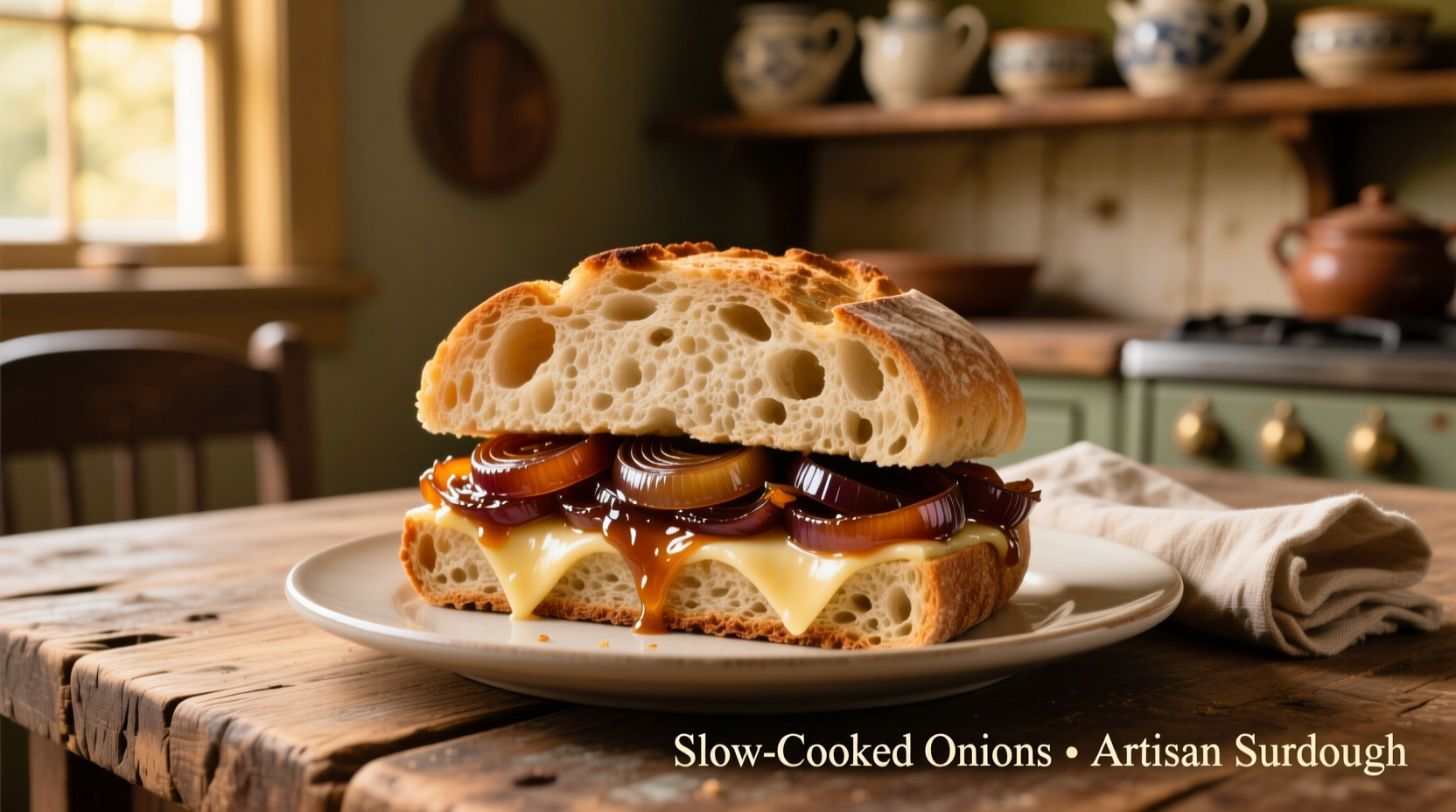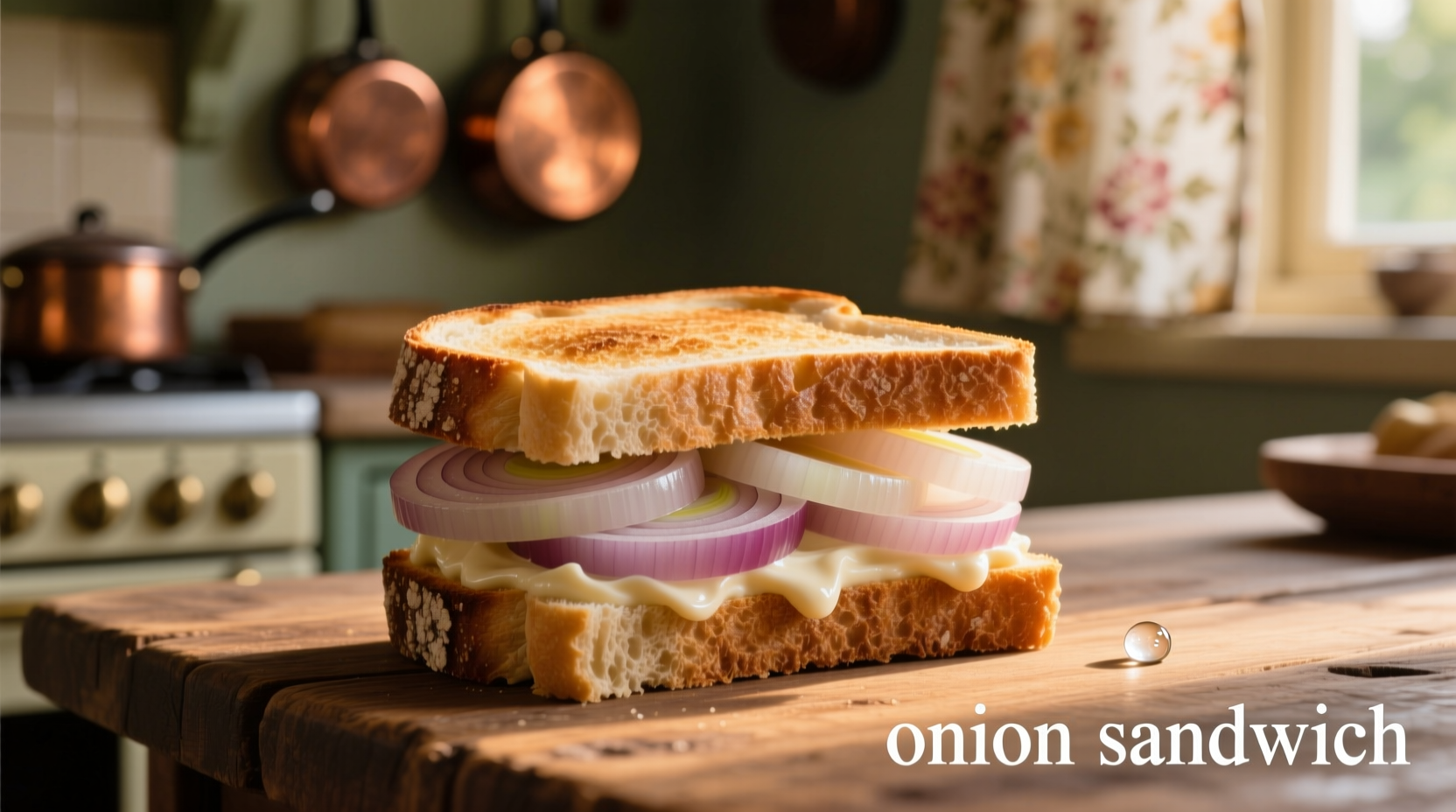Forget everything you think you know about boring sandwiches. The humble onion sandwich has quietly been winning over food enthusiasts with its surprising depth of flavor and versatility. Whether you're looking for a quick vegetarian meal, exploring historical recipes, or seeking ways to elevate simple ingredients, understanding the art of the onion sandwich delivers immediate culinary rewards.
The Unexpected Journey of Onion Sandwiches Through Time
While onions have been cultivated for over 5,000 years, their starring role in sandwiches emerged more recently. Historical records show that during World War I and II, when meat was rationed across Europe, resourceful cooks turned to caramelized onions as a satisfying meat substitute. British cookery books from the 1940s feature "onion sandwiches" as economical yet flavorful options for wartime meals.
| Era | Onion Sandwich Evolution | Historical Context |
|---|---|---|
| Ancient Times | Onions consumed raw or roasted | Used as currency and medicine in Egypt; mentioned in Indian Vedic texts |
| 19th Century | Onions added as condiment to meat sandwiches | British cookbooks mention onions as accompaniment to cold meats |
| WWI-WWII | Onions become primary sandwich filling | Rationing led to creative vegetarian alternatives across Europe |
| Modern Era | Gourmet variations emerge globally | Chefs experiment with different onion varieties and preparation methods |
Why Onion Sandwiches Actually Taste Amazing
The magic happens through the Maillard reaction and caramelization. When onions cook slowly, their natural sugars (fructose and sucrose) break down, creating over 500 different flavor compounds. This chemical transformation turns sharp, pungent onions into sweet, complex fillings with deep umami notes that satisfy our taste receptors in ways few other vegetable preparations can.
According to research published in the Journal of Agricultural and Food Chemistry, caramelized onions develop significant amounts of glutamates—compounds responsible for savory umami taste—making them surprisingly satisfying as a primary sandwich component. The key is patience: proper caramelization takes 30-45 minutes of slow cooking to develop these complex flavors fully.

Perfecting Your Onion Sandwich: Practical Techniques
Not all onion sandwiches are created equal. The difference between a mediocre and exceptional onion sandwich comes down to three critical factors:
1. Choosing the Right Onion Variety
- Yellow onions: Best for caramelizing (70% of onion's sugar content)
- Red onions: Ideal for quick-pickled sandwiches (vibrant color, milder flavor)
- Shallots: For delicate, nuanced sandwiches (higher sugar content)
- Green onions: Perfect for fresh, crunchy sandwiches (minimal cooking)
2. Mastering the Cooking Process
Professional chefs recommend this method for perfect caramelized onions:
- Slice onions evenly (1/8 inch thick) using a mandoline for consistency
- Cook over medium-low heat with equal parts butter and oil (prevents burning)
- Add a pinch of sugar and splash of balsamic vinegar to accelerate caramelization
- Cook for 30-45 minutes until deep golden brown, stirring occasionally
- Season with flaky sea salt just before removing from heat
3. Selecting Complementary Elements
The supporting ingredients make or break your onion sandwich:
- Bread: Choose sturdy, crusty bread like sourdough or rye that won't become soggy
- Spread: Mustard, garlic aioli, or whipped goat cheese create flavor bridges
- Texture: Add crispy elements like fried capers or toasted nuts for contrast
- Acidity: A splash of sherry vinegar or lemon juice cuts through richness
Global Onion Sandwich Variations Worth Trying
While the basic concept remains consistent, different cultures have developed distinctive onion sandwich preparations:
- French Welsh rarebit variation: Caramelized onions mixed with melted Gruyère cheese and mustard on baguette slices
- Indian pyaaz ki bhaji: Spiced onion fritters served between toasted bread with mint chutney
- Mexican cebollas asadas: Grilled red onions with lime and cilantro on bolillo rolls
- Eastern European cebularz adaptation: Onion-filled flatbread transformed into portable sandwiches
Avoiding Common Onion Sandwich Mistakes
Even experienced cooks make these critical errors that compromise flavor:
- Rushing caramelization: High heat creates bitter, burnt onions instead of sweet, complex flavors
- Skipping salt: Salt drawn out during cooking prevents proper browning
- Using wet bread: Toast bread first to create moisture barrier against soggy sandwiches
- Overloading: Too many onions create structural instability and overwhelm other flavors
- Forgetting resting time: Let caramelized onions rest 5 minutes before assembling to concentrate flavors
When an Onion Sandwich Works Best (And When It Doesn't)
Understanding the appropriate context for onion sandwiches prevents disappointing results:
- Ideal occasions: Light lunches, vegetarian meal options, using surplus garden onions, quick weeknight dinners
- Best pairings: Hearty soups, green salads, roasted vegetables, or as part of a charcuterie board
- Limitations: Not suitable as main course for large appetites without protein additions
- Special considerations: Raw onion sandwiches work best in summer; caramelized versions shine in cooler months
Simple Caramelized Onion Sandwich Recipe
This basic recipe serves as your foundation for endless variations:
- 2 large yellow onions, thinly sliced
- 2 tbsp unsalted butter
- 1 tbsp olive oil
- 1 tsp brown sugar
- 1 tbsp balsamic vinegar
- 4 slices sourdough bread
- 2 tbsp whole grain mustard
- Flaky sea salt and freshly ground pepper
- Melt butter with olive oil in skillet over medium-low heat
- Add onions, sugar, and a pinch of salt; cook slowly for 35-40 minutes
- Stir in balsamic vinegar during last 5 minutes of cooking
- Toast bread while onions cook
- Spread mustard on bread, add onions, season with salt and pepper
- Cut diagonally and serve immediately











 浙公网安备
33010002000092号
浙公网安备
33010002000092号 浙B2-20120091-4
浙B2-20120091-4